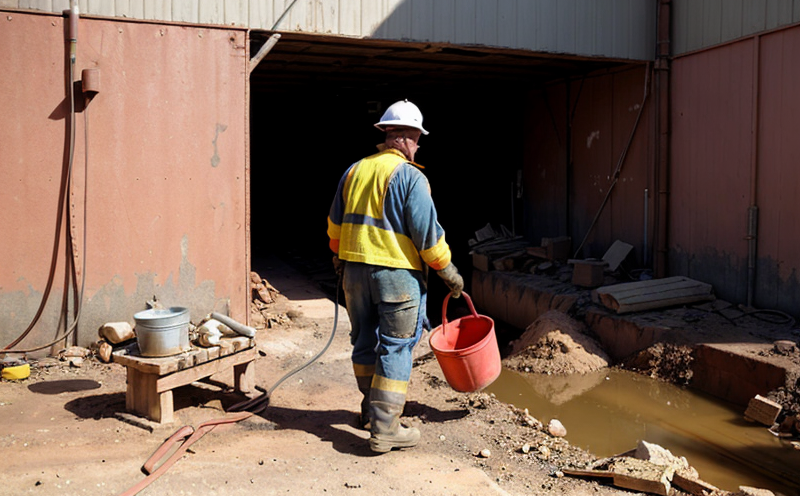EN 388 Mechanical Resistance of Protective Gloves Testing
In the mining sector, where safety and occupational health are paramount due to the hazardous conditions involved in extracting raw materials from the earth, ensuring that protective gloves meet stringent mechanical resistance standards is critical. The European Standard EN 388 provides a framework for assessing the mechanical resistance properties of protective gloves against abrasion, tear, cut, and puncture forces. This service ensures compliance with these standards to protect workers' hands from potential hazards on mining sites.
The test method specified in EN 388 is essential for quality assurance programs aimed at safeguarding employee health and preventing workplace injuries. By conducting this testing, we help our clients meet regulatory requirements while enhancing the overall safety culture within their organizations. Our team of experts uses advanced laboratory equipment to perform these tests accurately and reliably.
The mechanical resistance testing procedure involves subjecting gloves to various stressors designed to simulate real-world conditions encountered by miners during operations. This includes abrasion against rough surfaces, tearing under tension, cutting forces from sharp objects, and puncture resistance due to needles or similar protrusions. Each test parameter has its own set of criteria that must be met for the glove to pass, ensuring it offers adequate protection.
Our laboratory adheres strictly to international standards such as EN 388 when performing these tests. Compliance with these guidelines ensures consistency across different environments and promotes trust among stakeholders. Additionally, our team stays updated on any changes or updates to relevant standards so that we can provide accurate testing services according to the latest requirements.
Real-world application of EN 388 mechanical resistance testing extends beyond mere compliance—it plays a crucial role in maintaining worker safety by identifying weak points in protective gear before they become significant issues. For instance, if a particular type of glove fails during cut resistance tests, this information can guide manufacturers towards improving their designs and materials for future products.
For quality managers responsible for overseeing compliance efforts at large enterprises or smaller operations alike, understanding the importance of mechanical resistance testing cannot be overstated. It serves not only as part of an overall strategy but also helps foster a culture dedicated to continuous improvement in occupational health practices within mining companies.
In summary, our EN 388 mechanical resistance of protective gloves testing service is tailored specifically for those operating within the mining sector who prioritize worker safety above all else. By adhering meticulously to international standards like EN 388 and leveraging state-of-the-art technology, we ensure accurate results that contribute positively towards enhancing occupational health across this vital industry.
Scope and Methodology
The scope of our EN 388 mechanical resistance testing encompasses a comprehensive examination of protective gloves used in mining environments. Our methodology follows the guidelines outlined by European Standard EN 388, which covers four main aspects: abrasion resistance (P), cut resistance (C), tear resistance (T), and puncture resistance (I). Each section is evaluated individually to determine whether the glove meets the necessary performance levels.
- Abrasion Resistance: The test involves rubbing a sample of the glove against an abrasive surface at specified force values until it shows signs of wear. This helps assess how well the material holds up under repeated use conditions encountered on mining sites.
- Cut Resistance: Samples are exposed to blades with varying edge angles and sharpness levels, simulating potential hazards like metal fragments or glass shards that might be present during excavation activities. The aim is to measure how long it takes for the blade to penetrate through the glove material.
- Tear Resistance: This test evaluates a sample's ability to withstand stretching forces without tearing apart. It mimics situations where excessive pulling could occur while handling heavy equipment or materials.
- Puncture Resistance: Here, needles of different diameters are inserted into the glove until they cause penetration. Puncture resistance indicates how effective the material is at preventing sharp objects from piercing through it.
After completing all these tests, our technicians compile detailed reports highlighting each parameter's performance alongside graphical representations like graphs and charts for easier interpretation by clients.
Quality and Reliability Assurance
- Accurate Equipment: We utilize high-precision instruments calibrated regularly to ensure consistent and accurate measurements throughout the testing process. These tools are essential in providing reliable data that can be trusted by our customers.
- Standard Operating Procedures: Our team follows strict protocols based on EN 388, ensuring that every test is conducted under controlled conditions conducive to obtaining valid results.
- Data Validation: All collected data undergoes rigorous validation checks to eliminate any discrepancies or errors before being reported. This step adds an extra layer of assurance regarding the integrity and accuracy of our findings.
To maintain high standards, we also participate in proficiency testing programs recognized internationally, allowing us to benchmark ourselves against other reputable laboratories. By doing so, we demonstrate our commitment to excellence in providing dependable services.
Customer Impact and Satisfaction
- Enhanced Safety: By ensuring that protective gloves meet the mechanical resistance requirements set forth by EN 388, we contribute significantly towards improving worker safety on mining sites. This reduces the risk of injuries caused by accidental cuts, punctures, tears, or abrasions.
- Compliance Assurance: Our service assists customers in meeting regulatory obligations related to occupational health and safety. This not only protects them from potential legal penalties but also enhances their reputation as responsible employers.
- Improved Product Quality: Through our testing, manufacturers can identify areas where improvements are needed for their products. This leads to enhanced product quality over time, which translates into better performance under actual working conditions.
Our clients benefit from increased customer confidence and loyalty due to the assurance provided by passing EN 388 mechanical resistance tests. Moreover, successful completion of these tests can open up new markets or opportunities for business growth within existing ones.





